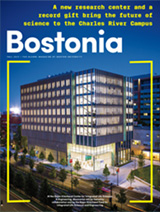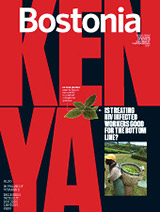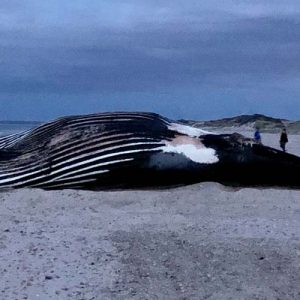The salt marshes near Herring Cove Beach in Provincetown are no one’s choice for a sunbathing spot. Your footfalls squelch in muck crawling with fiddler crabs—and that’s assuming you’re not swallowed by the hidden knee-high sinkholes. So it’s hardly surprising that the strollers walking past the marsh on a mid-August day are throwing quizzical glances at the small group of BU students clustered in its tall grass.
“I’ve seen lots of Speedos” go by during numerous visits over the summer, says Hollie Emery (GRS’16). She herself sports appropriate marsh attire: sleeveless shirt, tights, and waders. Nearby stand structures resembling solar panels, with six-foot-square plastic trays angled atop white-pipe legs. This human-made invasive species in the marsh, constructed by Emery in April, is helping her research what climate change is doing to this important natural gem at the tip of Cape Cod.
Climate change is expected to alter the weather in coming decades, with fewer, more intense storms punctuated by long drought periods forecast. What effects will that have on salt marshes, which sponge greenhouse gases from the atmosphere, buffer coastlines against sea surges, and shelter vital fish species? Emery is trying to find out by simulating that weather future now. Pencil-thin tubing funnels rainwater collected in trays into the plots of ground below. By targeting where the water goes, she can replicate different weather conditions on the plots. One is subject to drought, receiving no rain; one is drenched, receiving lots of rain in a simulation of a storm; one is subject to alternating periods of drought and heavy rain; and yet another does not have a rain panel on it. This one is a control for the experiment, receiving whatever precipitation Mother Nature decides to dump.
Three such research stations form a triangle sprawling across several hundred yards, reachable by traipsing through the tidal pools pockmarking the marsh. Emery and her team spent the summer measuring changes in the levels of three greenhouse gases—carbon dioxide, methane, and nitrous oxide—emitted from each plot by the marsh’s decomposing vegetation. They also take other vital signs from different sites around the marsh, such as temperature and humidity levels.
With 15 plots to monitor, it’s daunting work. The day a Bostonia team is shadowing Emery, it takes her, her sister Julie, and assistants Sarabeth Buckley (GRS’19) and Michelle Chen (CAS’15) most of the workday to collect data, using two methods. One employs a portable data analyzer; with the other, the researchers place small, airtight chambers on each plot, then extract gas samples with a syringe. Together, these methods allow the researchers to measure fluxes in the three greenhouse gases.

Emery (foreground) oversees climate change experiments with her team in a Cape Cod marsh.
Another challenge to conducting good science is the Atlantic Ocean, which doesn’t always cooperate with a PhD candidate and her team. Arriving shortly after 9 a.m. on this particular August day, they find that a heavy log has floated in on the high tide, catching on one of her research panels and dislodging some water tubing. They wait until 4:30 that afternoon for the tide to crest again so that they can float the log clear of the equipment.
The marsh is part of the Cape Cod National Seashore, which is overseen by the National Park Service. Both entities are funding Emery’s experiments through May, hoping to fill in blanks about their understanding of the marsh’s vital functions and how climate change might affect them.
Marsh grasses take in carbon dioxide from the atmosphere, like that emitted by human activity—and carbon dioxide is a major greenhouse gas. “Per unit of area, the grasses sequester more carbon than forests do,” Emery says. Might the forecasted drought spells stress marsh grass to such an extent that it inhales less carbon? Might the weather alter the decomposition rate and thus the ability to sequester carbon?
By manipulating the amount of rainwater that each of her research plots receives, Emery hopes to answer those questions. Her theory is that “the plants could grow a bit better and decomposition could occur a bit more. So those things may cancel each other out,” leaving the marsh’s carbon-catching function intact. But it’s also possible that greater carbon emissions from greater marsh decomposition in the future could outweigh the plants’ carbon collection and make marshes less useful in holding carbon. “We don’t quite know,” she says. Preliminary results suggest moisture is more important than temperature in controlling carbon dioxide emissions—which makes the coming weather and precipitation changes all the more vital to study, Emery notes.
The Park Service needs Emery’s work to answer another question. Climate change famously is causing rising sea levels, which could flood coastal marshes like the Cape Cod National Seashore in future years. The Park Service wants researchers’ guidance as it strategizes to protect those marshes. If Emery finds that changing weather patterns lead to faster decomposition and erosion of the marsh, “it might sink below current sea level or not keep up with future sea level rise,” she says. “That is another whole set of questions and answers that I’m going after.”
While the National Seashore has about 10 staff researchers, outside studies like Emery’s “are extremely important, because there’s no shortage of data to collect,” says Stephen Smith, a National Seashore plant ecologist.

Emery checks the stations she built to study climate change in a Provincetown marsh (left). A chamber the team uses to collect marsh gas samples (right)
“It’s kind of an informational gap in our knowledge, our understanding about the structure and function of salt marshes,” he says. “Emery’s really filling a scientific need for us.…The vertical buildup of marsh over time through sedimentation—we don’t really have any good handle on what those numbers are, how fast it’s occurring.” Her work might suggest some marshes build up sediment quickly enough to retreat inland ahead of rising seas; if there’s available land in the marshes’ path that can be spared or reclaimed from development, the Park Service and others might be able to protect that land, Smith says.
You could say marshes are in Emery’s blood—in fact, during her childhood, they were in her house. Growing up by a freshwater marsh in Wayland, Mass., she was used to her family’s shutting off the electricity during the occasional flood that poured water into their home. “I remember making Pop Tarts on an open fire when I was about 10,” she says.
When she married last summer—her husband is a beer brewer she’s known since they were undergraduates at the University of Massachusetts—her BU faculty advisor, Robinson “Wally” Fulweiler, “suggested I take my honeymoon on the Cape,” Emery says. “And she was only half kidding.” While the newlyweds opted for New Hampshire instead, Fulweiler, a College of Arts & Sciences associate professor of biology and of earth and environment, is fully serious about the importance of her student’s research.
Salt marshes “are under siege from a variety of human activities,” Fulweiler says, including the coming changes in the amount and timing of rainfall. “Hollie has designed a large-scale experiment that specifically addresses this change. Her work is timely and particularly relevant to the future management, protection, and perhaps even restoration of salt marshes.”
While her research focuses on just one Massachusetts marsh, Emery says, “my results are hopefully going to be general enough that they can be used to inform protection of all different types of marshes.”
















































Related Stories
Good News and Bad News about Forest Fragmentation
New England forest edges absorb more carbon but suffer more heat stress
Science under Our Feet
BU researcher studies ecology, and climate consequences, of Boston’s groundwater
Boston Awards BU a Carbon Cup
For being ahead of schedule in cutting greenhouse gases
Post Your Comment